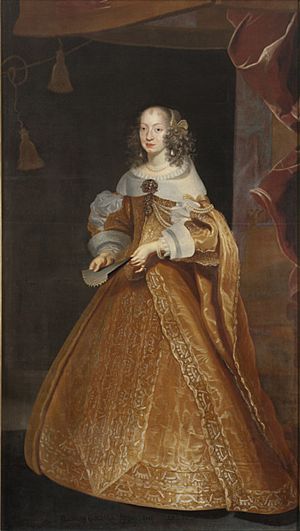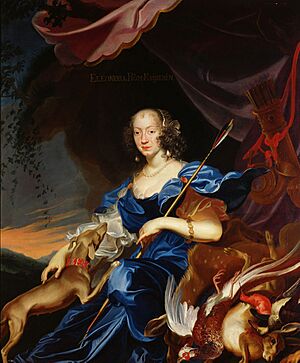Eleonora Gonzaga (1630–1686) facts for kids
Quick facts for kids Eleonora Gonzaga |
|
|---|---|

Portrait by Frans Luycx, ca. 1650.
|
|
| Holy Roman Empress (more...) | |
| Tenure | 30 April 1651 – 2 April 1657 |
| Coronation | 4 August 1653 |
| Born | 18 November 1630 Mantua, Duchy of Mantua |
| Died | 6 December 1686 (aged 56) Vienna, Austria |
| Burial | Imperial Crypt, Vienna, Austria |
| Spouse | |
| Issue Detail |
|
| House | Gonzaga |
| Father | Charles Gonzaga, Duke of Nevers |
| Mother | Maria Gonzaga, Duchess of Montferrat |
| Religion | Roman Catholicism |
Eleonora Gonzaga (born November 18, 1630 – died December 6, 1686) was a princess from the House of Gonzaga in Italy. She became the Holy Roman Empress, German Queen, and Queen of Hungary and Bohemia when she married Emperor Ferdinand III.
People called her the Younger to tell her apart from her great-aunt, who had the same name. Eleonora was known for being very smart and kind. She loved religious poetry and even started a special club for writers. She also supported music and theater. As Empress, she helped make the Imperial court in Vienna a lively place for culture and art. Even though she was a strong Catholic, she was open-minded towards Protestantism.
Eleonora also created two special groups for women: the Order of Virtuosity in 1662 and the Order of the Starry Cross in 1668.
Contents
Eleonora Gonzaga's Life Story
Her Early Years
Eleonora was born in Mantua, Italy, on November 18, 1630. She was the second child of Charles Gonzaga, Duke of Nevers and Maria Gonzaga, Duchess of Montferrat. Her family was very important in Italy.
When Eleonora was a baby, her family had to leave Mantua because of a big fight over who would rule the area. This fight was called the War of the Mantuan Succession. They came back a year later after a peace agreement was signed. Sadly, her father died soon after.
Eleonora lived with her mother in a church for some years. In 1637, her older brother became the new Duke, and their mother became his regent (a temporary ruler). Eleonora received an excellent education. She learned to speak French, Spanish, and Italian. She also studied literature, music, and art, and was good at dancing and embroidery. Even as a teenager, she wrote beautiful poems about philosophy and religion.
Her Royal Marriage and Children
Eleonora's marriage was arranged by her godmother, who was also named Eleonora Gonzaga and was a former Holy Roman Empress. Her godmother wanted Eleonora to marry Emperor Ferdinand III.
The Emperor agreed to the marriage if Mantua stayed loyal to the Holy Roman Empire. He also wanted a large dowry (money or property given by the bride's family). Eleonora's family agreed, but with some small changes.
The wedding ceremony, where someone stood in for the Emperor, happened on March 2, 1650, in Mantua. The celebrations lasted for many days. Eleonora then traveled to Vienna, Austria. On April 30, 1651, she officially married Emperor Ferdinand III in Wiener Neustadt. This was Ferdinand's third marriage.
Even though there was a big age difference, Eleonora and Ferdinand had a happy marriage. Eleonora was active and sweet, and everyone in the Imperial family liked her. She got along well with all of her stepchildren. She learned German, and the Emperor learned Italian. They enjoyed going to religious events, plays, and hunting together. Hunting was one of Eleonora's favorite hobbies.
Eleonora had four children with Emperor Ferdinand III, but only two lived to be adults:
- Eleonora Maria Josepha (born 1653 – died 1697), who became Queen of Poland.
- Maria Anna Josepha (born 1654 – died 1689), who became an Electoral Princess.
Becoming Empress and Queen
Eleonora was a very cultured woman. She and her husband started a special group for writers and thinkers. Even though they were strict Catholics, they welcomed Protestants into this group. Eleonora always spent time with educated people and encouraged new ideas in science.
After she arrived in Vienna, Italian culture became very popular. Italian was often spoken among the German nobles, and Italian fashion was everywhere. This influence was seen in literature, music, theater, and art.
Eleonora often traveled with her husband throughout the Holy Roman Empire. In 1652–1654, she was with him in Regensburg for an important meeting called the Reichstag. While her husband worked on government matters, she organized fun events like the Carnival before Lent, which included a new opera.
She was crowned Holy Roman Empress on August 4, 1653, in Regensburg Cathedral. She was also crowned Queen of Hungary in 1655 and Queen of Bohemia in 1656. In April 1657, her husband, Emperor Ferdinand III, passed away, and Eleonora became a widow. Her only son died a year later.
Life as a Widow
As a widow, Eleonora was given money and properties to support herself. She spent her summers at the Favorita palace, which she received from her godmother. She also helped oversee changes to the Hofburg Palace.
Eleonora's small court became a place where important politicians and diplomats would meet. There was talk of her marrying again, perhaps the King of Poland, but it never happened.
Eleonora was highly respected by her stepson, Leopold I, who became the new Emperor. He often asked her for advice on important matters. She also got along well with his wives.
She sometimes got involved in politics, especially to help her family. For example, in 1669, she helped solve a disagreement between the Imperial court and the Holy See (the Pope). In 1671, she arranged a marriage for her nephew to bring two rival Gonzaga families together.
Besides politics, Eleonora spent much of her time helping others and supporting religious causes. She invited a famous preacher, Marco d'Aviano, to Linz. She also supported artists and ordered the building of new church facades in Vienna. She helped the Discalced Carmelites build a monastery. To improve education for girls, she invited the Ursulines to Vienna in 1663, where they built a school. She also founded two important orders for women: the Order of Virtuosity in 1662 and the Order of the Starry Cross in 1668.
Her Final Years
The last years of Eleonora's life were difficult. There was a terrible plague in 1679, and then a big war, the Great Turkish War, started in 1683. During both events, she had to leave Vienna for safety.
Eleonora passed away in Vienna on December 6, 1686. She was buried in the Imperial Crypt, a special burial place for royalty in Vienna.
Images for kids
-
Portrait by Frans Luycx, ca. 1650.
-
Empress Eleonora as Diana, by Frans Luycx, ca. 1651.




